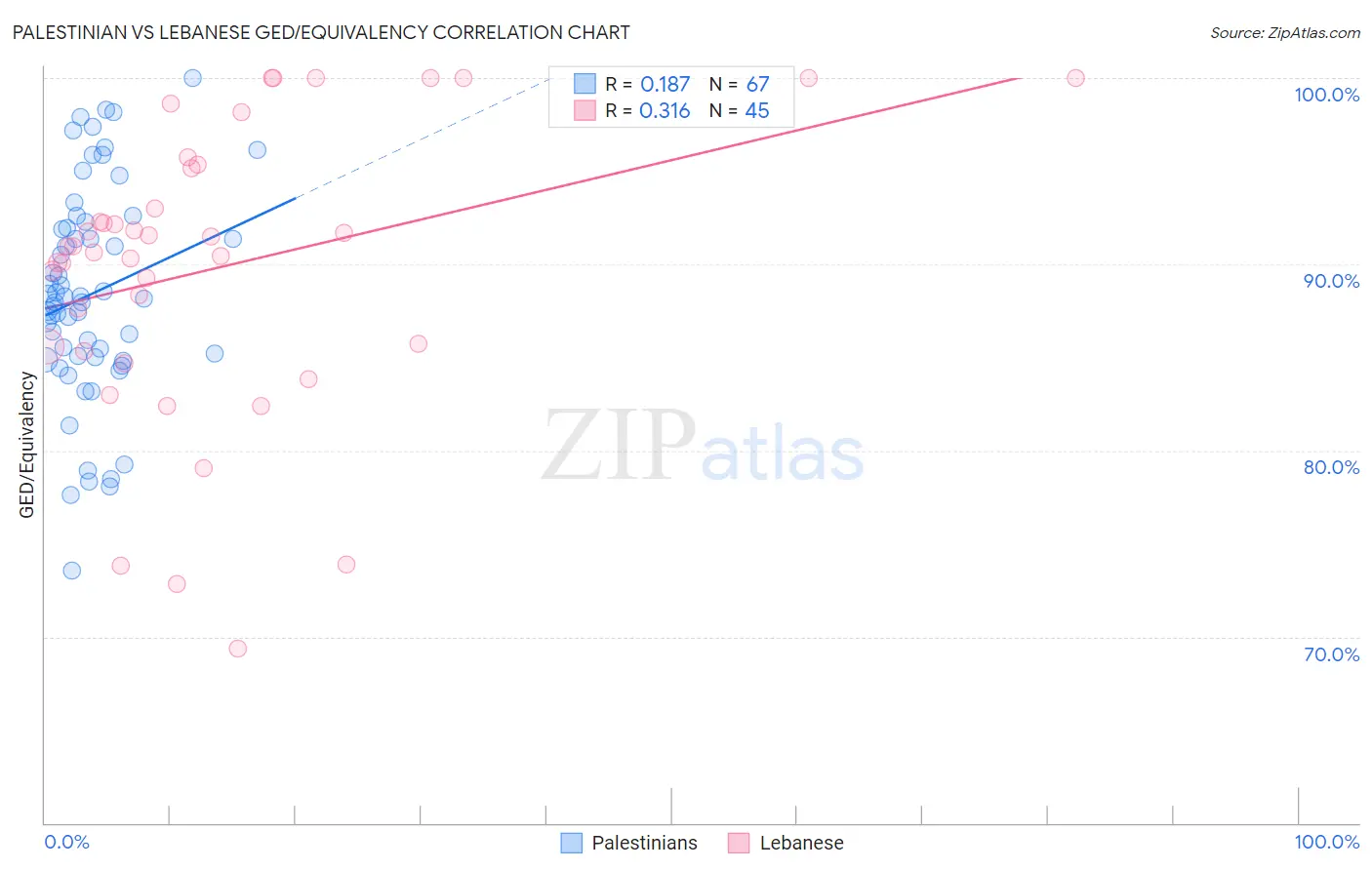Palestinian vs Lebanese GED/Equivalency
COMPARE
Palestinian
Lebanese
GED/Equivalency
GED/Equivalency Comparison
Palestinians
Lebanese
87.3%
GED/EQUIVALENCY
96.8/ 100
METRIC RATING
100th/ 347
METRIC RANK
87.2%
GED/EQUIVALENCY
96.2/ 100
METRIC RATING
102nd/ 347
METRIC RANK
Palestinian vs Lebanese GED/Equivalency Correlation Chart
The statistical analysis conducted on geographies consisting of 216,461,770 people shows a poor positive correlation between the proportion of Palestinians and percentage of population with at least ged/equivalency education in the United States with a correlation coefficient (R) of 0.187 and weighted average of 87.3%. Similarly, the statistical analysis conducted on geographies consisting of 401,624,313 people shows a mild positive correlation between the proportion of Lebanese and percentage of population with at least ged/equivalency education in the United States with a correlation coefficient (R) of 0.316 and weighted average of 87.2%, a difference of 0.090%.

GED/Equivalency Correlation Summary
| Measurement | Palestinian | Lebanese |
| Minimum | 73.5% | 69.4% |
| Maximum | 100.0% | 100.0% |
| Range | 26.5% | 30.6% |
| Mean | 88.4% | 89.8% |
| Median | 88.2% | 90.9% |
| Interquartile 25% (IQ1) | 85.0% | 85.5% |
| Interquartile 75% (IQ3) | 92.0% | 95.2% |
| Interquartile Range (IQR) | 7.0% | 9.8% |
| Standard Deviation (Sample) | 5.7% | 7.7% |
| Standard Deviation (Population) | 5.6% | 7.6% |
Demographics Similar to Palestinians and Lebanese by GED/Equivalency
In terms of ged/equivalency, the demographic groups most similar to Palestinians are Immigrants from Belarus (87.3%, a difference of 0.020%), Immigrants from Croatia (87.3%, a difference of 0.030%), Syrian (87.2%, a difference of 0.030%), Immigrants from Western Europe (87.3%, a difference of 0.090%), and Jordanian (87.2%, a difference of 0.10%). Similarly, the demographic groups most similar to Lebanese are Jordanian (87.2%, a difference of 0.010%), Immigrants from Hungary (87.2%, a difference of 0.020%), Indian (Asian) (87.1%, a difference of 0.030%), Immigrants from Zimbabwe (87.1%, a difference of 0.050%), and Syrian (87.2%, a difference of 0.060%).
| Demographics | Rating | Rank | GED/Equivalency |
| Immigrants | Eastern Asia | 97.9 /100 | #91 | Exceptional 87.4% |
| Israelis | 97.8 /100 | #92 | Exceptional 87.4% |
| Immigrants | North Macedonia | 97.8 /100 | #93 | Exceptional 87.4% |
| Immigrants | Russia | 97.8 /100 | #94 | Exceptional 87.4% |
| Immigrants | Greece | 97.7 /100 | #95 | Exceptional 87.4% |
| Czechoslovakians | 97.6 /100 | #96 | Exceptional 87.4% |
| Immigrants | Western Europe | 97.3 /100 | #97 | Exceptional 87.3% |
| Immigrants | Croatia | 96.9 /100 | #98 | Exceptional 87.3% |
| Immigrants | Belarus | 96.9 /100 | #99 | Exceptional 87.3% |
| Palestinians | 96.8 /100 | #100 | Exceptional 87.3% |
| Syrians | 96.6 /100 | #101 | Exceptional 87.2% |
| Lebanese | 96.2 /100 | #102 | Exceptional 87.2% |
| Jordanians | 96.1 /100 | #103 | Exceptional 87.2% |
| Immigrants | Hungary | 96.0 /100 | #104 | Exceptional 87.2% |
| Indians (Asian) | 95.9 /100 | #105 | Exceptional 87.1% |
| Immigrants | Zimbabwe | 95.8 /100 | #106 | Exceptional 87.1% |
| Icelanders | 95.7 /100 | #107 | Exceptional 87.1% |
| Canadians | 95.6 /100 | #108 | Exceptional 87.1% |
| Immigrants | Eastern Europe | 95.5 /100 | #109 | Exceptional 87.1% |
| Egyptians | 95.3 /100 | #110 | Exceptional 87.1% |
| French | 95.2 /100 | #111 | Exceptional 87.1% |